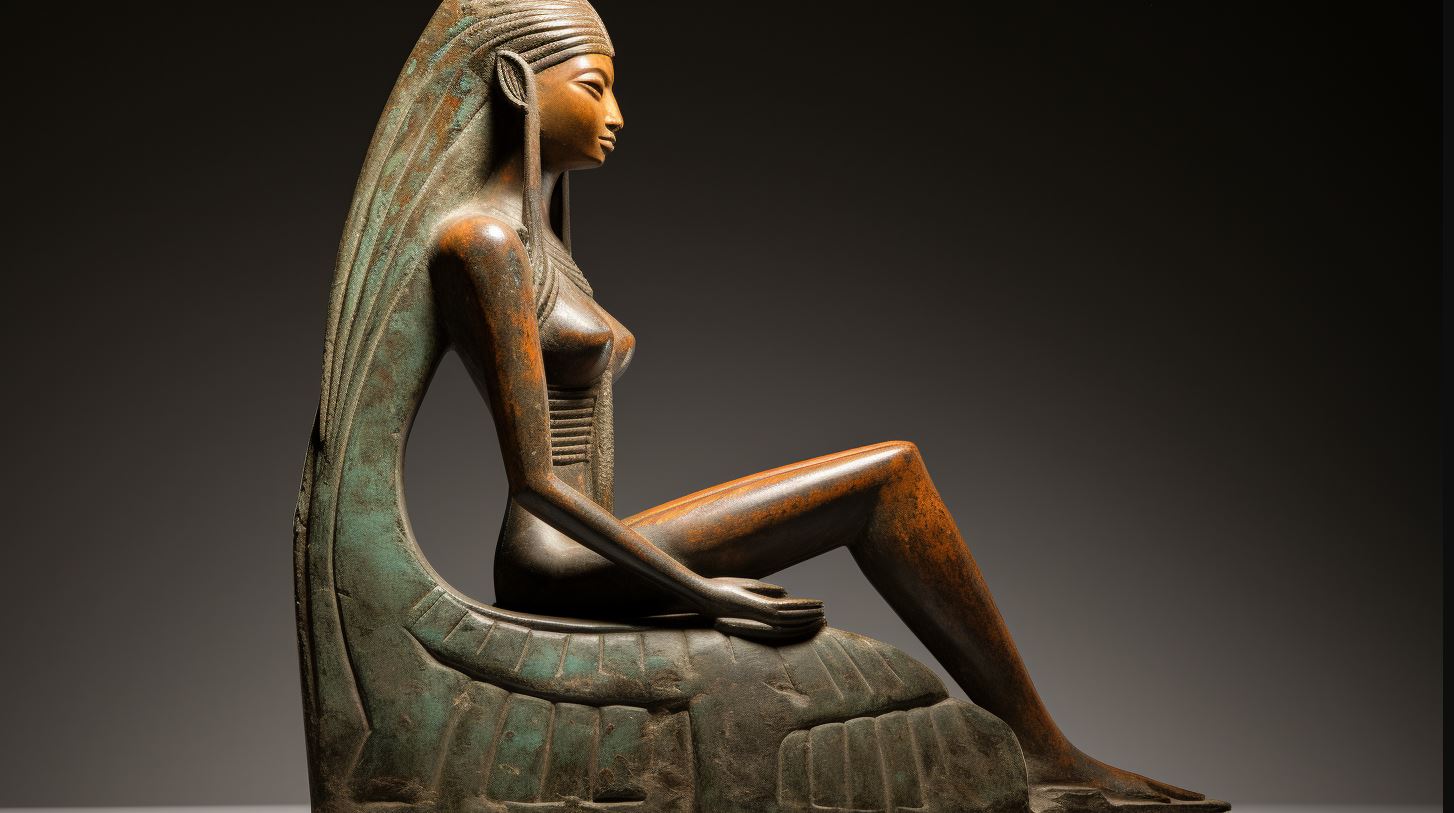Baalshamin God: Exploring the Ancient Middle Eastern Deity and its Significance

Baalshamin God was a revered deity in ancient Middle Eastern communities, particularly among the Canaanites. Worshiped as a fertility god, Baalshamin held great significance in their pantheon. Tablets discovered in Ugarit, Syria, dating back to the second millennium BC, shed light on Canaanite beliefs and their association of fertility with Baalshamin.
Legends tell of Baalshamin’s battles against Mot, the god of death, where victory ensured seven years of fertility, while defeat resulted in drought and famine. Baalshamin’s prominence extended to Palmyra, where sadly, the Temple of Baalshamin met a tragic fate.
Baalshamin: The Fertility and Rain God
Baalshamin was a prominent deity associated with fertility and agriculture in ancient civilizations. Cultures revered him as a powerful entity responsible for ensuring prosperous harvests and abundance in the land. His influence extended beyond mere agricultural aspects, as he was also worshiped for his control over rain and dew, which were crucial for the fertility of the Canaanite region.
Baalshamin’s role as a deity of fertility and agriculture
Baalshamin held a significant role in the pantheon of deities as the universal god of fertility. The ancient Canaanites believed that his blessings guaranteed bountiful crops, ensuring the well-being and prosperity of their communities.
They looked to him for favorable weather conditions, timely rain, and fertile soil, all of which were imperative for successful agricultural endeavors.
Importance of Baalshamin as the god of rain and dew
The devotion to Baalshamin was heightened due to his association with the vital elements of rain and dew.
Rainfall was essential for sustaining agriculture, and the Canaanites believed that Baalshamin held authority over such weather phenomena. They regarded the timely arrival of rain as a direct manifestation of Baalshamin’s benevolence, ensuring fertility and sustaining their livelihoods.
Dew, known for its moisturizing effect, was also considered a blessing from Baalshamin, further strengthening his reputation as a provider of abundance.
In conclusion, Baalshamin played a significant role as a fertility and rain god in ancient civilizations.
His worshippers looked to him for prosperous harvests and relied on his control over rain and dew to ensure the fertility of their lands. Baalshamin’s influence as a divine figure was crucial in sustaining the agricultural and economic well-being of the communities that revered him.
Baalshamin and the Canaanite Mythology
Baalshamin, the ancient Middle Eastern deity, played a significant role in Canaanite mythology. This section delves into two important aspects of Baalshamin’s mythology: his battles with Mot, the god of death, and the belief in seven-year fertility cycles associated with Baalshamin.
According to ancient tablets discovered in Ugarit, these battles held significant implications for the welfare of the land and its people.
Baalshamin’s victories over Mot ensured the prosperity and fertility of the earth.
The ancient Canaanites believed that when Baalshamin triumphed, bountiful harvests, abundant rain, and overall prosperity prevailed. However, if Mot emerged victorious, seven years of drought, famine, and barrenness plagued the land.
The belief in seven-year fertility cycles associated with Baalshamin
Central to the Canaanite belief system was the concept of fertility cycles lasting for seven years. These cycles were closely linked to Baalshamin’s battles with Mot. The ancient Canaanites believed that during the years of Baalshamin’s triumph, fertility and abundance flourished, ensuring the well-being of their communities.
Conversely, during the seven-year periods when Mot prevailed, the land suffered from the absence of rain, resulting in crop failure and scarcity. It was during these times of hardship and brutal conditions that the Canaanites sought to appease Baalshamin through rituals and offerings, praying for his victory over Mot and the restoration of fertility.
- During Baalshamin’s victorious years, fruitful harvests blessed the land.
- The power of rain and dew, essential for agricultural fertility, was associated with Baalshamin’s dominion.
- When Mot triumphed, the land experienced seven years of arid conditions and scarcity.
- Ancient Canaanites believed in the cyclical nature of fertility, hinging on Baalshamin’s success in battle.
Understanding Baalshamin’s battles with Mot and the belief in seven-year fertility cycles provides invaluable insights into the religious and cultural practices of ancient Middle Eastern communities.
Baalshamin’s Attributes and Relationships
Baalshamin, the ancient Middle Eastern deity, possessed various attributes and had significant relationships within the Canaanite pantheon. This section explores two important aspects of Baalshamin: his consort and sister, Anath, and his rivalry with Yamm, the god of the sea.
Baalshamin’s consort and sister, Anath
Anath played a crucial role in the mythology surrounding Baalshamin. As his consort and sister, she symbolized the duality of divine power and fertility. Anath was a fierce warrior goddess, known for her protective nature and association with warfare.
This elevated status attributed to his role as a provider of rain, which was vital for the fertility and prosperity of the land. However, Baalshamin’s reign was not without challenges.
One of his significant rivalries was with Yamm, the god of the sea.
Through these relationships and attributes, Baalshamin’s divine role as the bringer of fertility and rain intertwined with his position as the king of gods, showcasing the complexity and depth of his character within the ancient Middle Eastern religious traditions.
Baalshamin Worship in Different Cultures
Exploring the worship of Baalshamin in different cultures provides fascinating insights into the widespread influence of this ancient deity. Baalshamin, known as Belos in Egyptian mythology, was revered in ancient Egypt under various names.
As Belos, he held a significant place in Egyptian religious practices, particularly in relation to fertility and the cultivation of the land. Egyptian texts and artifacts depict Belos as a powerful god associated with abundance, growth, and the natural cycles of agricultural productivity.
Baalshamin in Egyptian mythology as Belos
Within the intricate tapestry of Egyptian mythology, Belos represented the divine force behind the annual flooding of the Nile River. This crucial event replenished the soil with nutrients and facilitated prosperous harvests.
The Egyptians recognized Belos’ role in sustaining fertility in the natural world, attributing the abundant agricultural yields to his benevolence. Belos was celebrated through elaborate rituals and ceremonies, showcasing the importance of his worship in the Egyptian society of the time.
Baalshamin’s local worship in various regions
Baalshamin’s influence reached beyond Egypt to different regions where he was worshipped as a local god, adapting to the unique cultural contexts. Local communities embraced Baalshamin and incorporated him into their religious practices, often intertwining his mythology with their existing belief systems.
This integration allowed for the assimilation of Baalshamin into diverse pantheons, blending his attributes with those of other deities and further extending his sphere of influence.
- Baalshamin’s worship in Canaan: Among the Canaanites, Baalshamin held a position of utmost significance as the deity of fertility and rain.
His worship played a central role in their agricultural practices and beliefs, emphasizing the vital connection between rains and abundant harvests.
- Baalshamin’s worship in Mesopotamia: In Mesopotamia, Baalshamin was known as Adad, the god of rain, storms, and thunder.
He was seen as a force capable of bringing life-giving rainfall to the parched lands of the region, essential for sustaining crops and livelihoods.
- Baalshamin’s worship in other ancient cultures: Beyond Egypt and Mesopotamia, Baalshamin’s worship spread to various ancient cultures, each incorporating his role as a fertility deity and rain-bringer in their own unique ways.
The extensive presence of Baalshamin’s worship throughout different regions and cultures attests to his enduring influence and significance in ancient societies.
The adaptability of Baalshamin’s mythology and his ability to assimilate into diverse belief systems underscored his importance as a god intimately tied to the prosperity of agricultural communities.
Baalshamin in Palmyra and the Destruction of the Temple
The city of Palmyra was a significant center for the worship of Baalshamin, attracting devotees from various regions.
As a deity associated with fertility and rain, Baalshamin held immense importance in the agricultural practices of the time.
Overview of Baalshamin worship in Palmyra
In Palmyra, the worship of Baalshamin was intertwined with the local culture and religious traditions. The city’s inhabitants revered Baalshamin as a powerful god who blessed them with abundant harvests and prosperity.
Devotees gathered at the magnificent Temple of Baalshamin to offer prayers, sacrifices, and seek blessings for their agricultural endeavors. The temple stood as a testament to the religious devotion and architectural finesse of the ancient Palmyrene civilization.
Tragic destruction of the Temple of Baalshamin in Palmyra
However, in a devastating turn of events, the Temple of Baalshamin fell victim to destruction and chaos. The exact circumstances surrounding its destruction remain shrouded in historical uncertainties, but it is widely believed that extremist forces during the ongoing conflict in the region targeted and demolished the sacred site.
This heartbreaking act of cultural vandalism not only stripped Palmyra of an architectural marvel but also inflicted immeasurable damage on the tangible remnants of the worship of Baalshamin. The loss of the temple serves as a solemn reminder of the fragile nature of our shared human heritage.
- The destruction of the temple represents a tragic loss for the world’s cultural heritage.
- The obliteration of a significant religious site like the Temple of Baalshamin not only deprives future generations of a tangible connection to the ancient past but also undermines the diversity and richness of global heritage.
- The urgent need for the preservation and protection of cultural sites, regardless of their religious or historical significance, cannot be overstated.
It is through education, awareness, and responsible stewardship that we can ensure the survival of our shared human legacy.
While the physical temple may be gone, the memory of Baalshamin and the significance of his worship continue to resonate through the annals of history.
It is our collective responsibility to honor and cherish the legacy of Baalshamin and preserve the knowledge and understanding of his cultural and religious importance for future generations.
Perspectives on the Destruction of the Temple
Reflection on the Impermanence of History and Art
The destruction of the Temple of Baalshamin in Palmyra evokes a reflection on the impermanence of history and art.
It serves as a poignant reminder that even the most revered cultural treasures are susceptible to devastation. The obliteration of this architectural marvel not only erases a symbol of religious worship but also erodes a tangible connection to the past.
As we contemplate the ruins of the temple, we are prompted to question the fleeting nature of human achievements. How can we hold on to a sense of cultural identity when tangible remnants of our history can be all too easily annihilated? The destruction of the Temple of Baalshamin underscores the vulnerability of our collective heritage.
Importance of Documenting and Educating about the Lost Heritage
While the Temple of Baalshamin may have been reduced to rubble, its significance can still be preserved through documentation and education. By meticulously recording the architectural details, historical context, and cultural significance of this ancient site, we can ensure that its memory endures.
- Documentation: Scholars, archaeologists, and historians must collaborate to create comprehensive records of the temple’s history, construction techniques, and artistic features. These detailed records serve as valuable resources for future generations, allowing them to study and appreciate the temple’s legacy.
- Educating: It is our responsibility to teach future generations about the lost heritage of the Temple of Baalshamin.
Through educational programs, exhibits, and publications, we can raise awareness about the temple’s significance within the broader context of ancient Middle Eastern cultures. By sharing this knowledge, we can foster a deep appreciation for the fragility and irreplaceability of our cultural heritage.
Although the physical temple may be gone, its impact can continue to resonate within our society.
By documenting and educating about the Temple of Baalshamin, we pay homage to the past while building a stronger, more resilient future.
…




















